Filing is a means of metal finishing a damaged panel prior to sanding operations for paint spraying. Essentially, panel beating is a hand method of producing hollow or double-curvature shapes by means of hammering and metal finishing nevertheless the panel beater’s craft still retains its place in body work and as yet is irreplaceable by more modern methods, in spite of the tremendous developments in recent years of mechanical methods of forming, panel beating remains as essential means of fabrication of special parts. Some metal shapes cannot be produced at all by mechanical methods and others only with great difficulty and in such cases panel beating is used to finish the shape that has been rouged out by power processes. Often, too, the prototype of a component ultimately to be made in quantity by stamping or pressing is hand made to allow minor modifications to be studied before mechanical production begins, the part produced by panel beating is used as the pattern for press or stamp tools. Panel beating may also be used where a small number of components only are required and where the cost of press or stamp tools would be uneconomic. In body repair work, panel beating is used to advantage where sections which are either unobtainable or uneconomical to replace completely can be fabricated by hand either in part or as a whole. In many cases corroded areas can be repaired by fabricating new sections for replacement purposes. In the body building trade, panel beating is still used to large extent where new vehicles are built either in aluminium or mild steel. Many of the components for these vehicles are still made using the traditional hand shaping methods. Also a lot of the aluminium moulds used in fibreglass construction, where highly developed double-curvature shapes are needed, are made by hand, welded and dressed, planishied or wheeled to a final finish.
Panel beating is essentially a hammering process, involving different kinds of blows that can be struck on sheet metal. It should be borne in mind that most metals used in body work possess high malleability and may be overstretched even with a wood tool. The three types of blow that can be struck on sheet metal are:
Solid Blow Where the work is struck solidly over a steel stake.
Elastic Blow where either the head or the toll or both is made of a resilient material such as wood.
Floating Blow where the stake is not directly under the hammer.
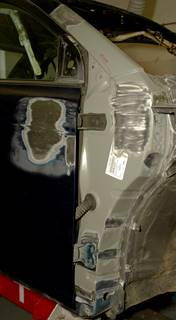 Each type of blow has its uses for particular purposes. A solid blow will stretch the sheet and may be necessary when forming a panel, bending a curved strip or angle, removing a loose or tight place in a sheet, or throwing an edge over when thickness is not a consideration. An elastic blow will form metal without undue stretching, indeed metal can be thickened if desired, as in working out a tuck or pucker. The floating blow is given to the metal when it is held over a suitable head and hit ‘off the solid’, so forming dents at the point of impact.
Each type of blow has its uses for particular purposes. A solid blow will stretch the sheet and may be necessary when forming a panel, bending a curved strip or angle, removing a loose or tight place in a sheet, or throwing an edge over when thickness is not a consideration. An elastic blow will form metal without undue stretching, indeed metal can be thickened if desired, as in working out a tuck or pucker. The floating blow is given to the metal when it is held over a suitable head and hit ‘off the solid’, so forming dents at the point of impact.
1.0 Metal Finishing Safety
When filing metal panels care should be taken with the edges of the panels as they become very shape from the filing. Always use gloves and goggles to protect your eyes from flying sparks and paint debris. Fireproof overalls, safety boots and ear muffs are also essential.
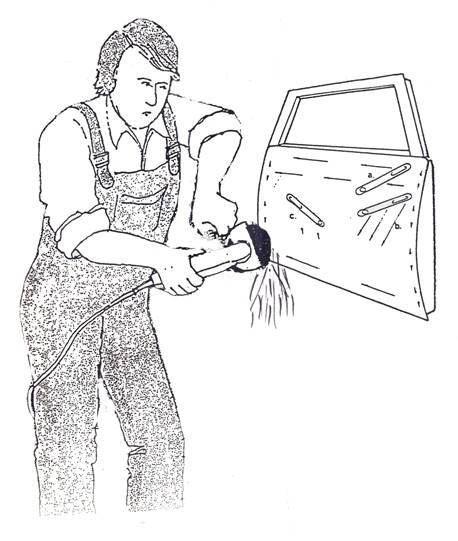
Figure 1: Grinding/Filing a Door Panel
2.0 Shaping Metal by Hand
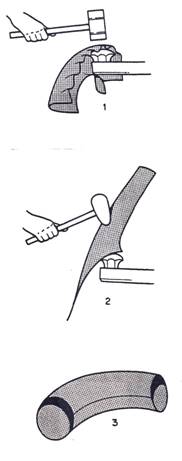 Thin-gauge mild steel and light aluminium sheet material up to 1.2mm and in some cases even 1.6mm can be satisfactorily hand beaten by wood mallets into double curvature forms (Figure 2). The usual practice is to beat the metal in a suitable recess in a wood block or upon a sandbag, in what is known as the hollowing or blocking process. Alternatively, the metal can be hammered into a wood block hollowed out to the shape of the job.
Thin-gauge mild steel and light aluminium sheet material up to 1.2mm and in some cases even 1.6mm can be satisfactorily hand beaten by wood mallets into double curvature forms (Figure 2). The usual practice is to beat the metal in a suitable recess in a wood block or upon a sandbag, in what is known as the hollowing or blocking process. Alternatively, the metal can be hammered into a wood block hollowed out to the shape of the job.
Another method is that of raising the metal by means of floating blows over steel stakes or wood formers. This raising process can be speeded up considerably by ‘taking in’ or making tucks at the edges of the metal. This method is generally called puckering and after being made each pucker must be eliminated by careful blows to drive the metal into itself, so thickening the work at the edges. Much greater advantage may be taken of puckering in aluminium alloy sheet than in most metals because of its malleability and ductility. The exact degree of shaping of the metal which is permissible depends upon the particular alloy being worked, its malleability and the ability of the craftsman.
Figure 2: Shaping Metal by Hand
Another method of shaping metal which can be used in conjunction with hollowing and raising is that of wheeling. A panel can either be wheeled from a flat sheet to the desired double-curvature shape, or it can be pre-shaped using either hollowing or raising technique and its final shaping and smoothing completed by wheeling. The technique of wheeling is not entirely done by hand, as a wheeling machine is used. The finished result depends on the skill of the craftsman as he manipulates the sheet by hand in the wheeling machine.
An experienced panel beater uses the beating method suitable to the job in hand, complex shapes often being beaten up by using both hollowing and raising or wheeling methods. For light-gauge material too much hollowing or blocking is not to be recommended, as it tends unduly to thin the metal. The skilled panel beater is a craftsman who, to a great extent, relies on a good eye for line and form, this can only be cultivated by years of experience which, combined with dexterity in the use of hand tools, is the secret of his craftsmanship. Wood formers or jigs, upon which the beaten shape can be tired in order to obtain uniformity of shape for each workpiece, are used for many jobs. The shape of the job is retained in the vision of the panel beater, who can, by beating on the sandbag and raising over a suitable stake, obtain a very good approximation to the desired form. This only needs hammering lightly on the wood former to obtain the finished shape. Until the metal fits the former it is often necessary to check repeatedly to find any high or low areas which may prevent the workpiece from fitting the former correctly. Instead of using formers or jigs many panel beaters use templates only, which are cut to the shape of the various cross-sections of the workpiece. These templates are used towards the end of the beating process to check the finished shape of the job. After shaping, the surface of the finished panel has to be smoothed by the technique of planishing, using a steel bench stake, or by wheeling.
2.1 Hollowing
One of the methods of shaping metal by hand is that of hollowing. In this method the metals used for the purpose of shaping panels for body work applications are usually aluminium and its alloys and mild steel, aluminium is by far the easier of the two to shape owing to its higher ductility and malleability properties. This is a process of shaping a sheet metal blank into a double-curvature shape by beating the blank into a sandbag or hard wood block with the aid of a pear-shaped boxwood mallet or for thin metal a rubber mallet, or for steel a hollowing hammer with a steel head.
First the blank which is going to be shaped is cut to size and the edges trimmed for any rag by filing. If the rag is not removed and the blank is shaped, it may tend to split from the edge of the rag. The next step is to place the metal blank, which should be held tilted, on to a sandbag and to give it a series of blows around its outside edge, working towards the centre by means of a pear-shaped mallet. This hammering has the effect of sinking the metal into the sandbag, which is of course resilient to the blows. After each blow the disc is turned and the next blow struck near the first one and so on until a series of lapping blows is made round the circumference of the blank. The tendency will be for creases or wrinkles to appear on the edges of the metal and these must be gently malleted flat to avoid overlapping of the metal and eventual cracking. The hammer of each course has to be done with steady and even blows to bring up a regular curved shape.
On completion of the first course of blows, a second course is begun further in from the edge of the metal than the first set. This process of hammering in courses and rotating the blank is continued until eventually the centre of the blank is reached, by this time it will have taken on a double curvature shape, but should greater depth be required the whole operation must be started again, working gradually from the edge towards the centre of the work until it is completely to the desired shape and size.
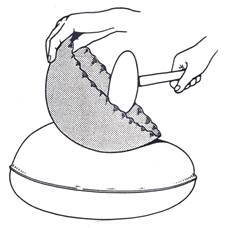 Figure 3: Technique of Hollowing
Figure 3: Technique of Hollowing
At this stage templates cut to the correct size and shape can be used to check that the panel being shaped is the correct size and curvature. Alternatively it is possible to use a jig constructed to the correct size and shape, usually in wood. It may be necessary during the beating-up process to anneal the workpiece to restore its malleability, because the hammering tends to harden the metal by work hardening. In some cases, instead of using a sandbag for the shaping to be carried out on, a hollowed-out recess in a wood block can be used. When the panel has reached the desired shape by hollowing it can be smoothed to a final finish by hand planishing using a hand dolly or over a stake, or wheeling to obtain the final smoothness.
2.2 Raising
Raising is another method of shaping metal by hand into a double-curvature shape. The method of raising is carried out by drawing the metal in courses over a suitably shaped steel stake or wood block, using floating blows which are struck slightly off the stake with a boxwood pear-shaped mallet. A series of blows is made in the metal starting at the centre, the blows being struck slightly off the stake. This has the effect of shrinking or reducing the circumference of the blank, thus forcing it down and around the stake. The disc or blank is rotated after each blow as in hollowing, but working from the centre in courses outwards towards the edges of the blank.
The same process is repeated with frequent annealing of the metal until the final degree of raising is reached and the desired shape obtained. In the course of the raising, the edges of the metal around the circumference will be continually subjected to creasing, care and skill is needed to avoid allowing these creases to become to sharp. If they are not worked out the edge will crack or fracture as the shape proceeds. When the 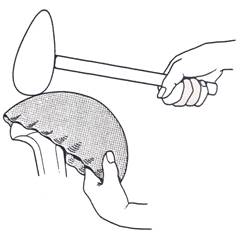 article is partly beaten up over the stake, a series of tucks can be made in the outer edges of the work in order to quicken up the beating or raising process by taking in or shrinking surplus metal. This method is to make a pucker or tuck at any point on the edge of the blank by bending the metal on a stake into an ear-shaped form.
article is partly beaten up over the stake, a series of tucks can be made in the outer edges of the work in order to quicken up the beating or raising process by taking in or shrinking surplus metal. This method is to make a pucker or tuck at any point on the edge of the blank by bending the metal on a stake into an ear-shaped form.
Figure 4: Raising
After the tuck is formed, the disc is placed on a steel stake and each side of the tuck is lightly malleted to stiffen the metal and hold the tuck in position. This is done in three or four places on the circumference of the blank thus decreasing its diameter. Then working from the base or point of the tuck, this surplus metal is malleted out over a stake towards the edge of the disc. This has to be done vary carefully with the minimum of blows and overlapping must not take place. As each tuck is formed and worked out, the blank deepens towards its final shape.
The processes of hollowing and raising in sheet metal are often applied together in the making of articles in the form of double-curvature shapes, bowl-like shapes etc. when the work is only slightly domed, the process of hollowing alone may be sufficient to complete the work. There are limitations to the depth which can be obtained by hollowing. This is governed by the diameter of the finished article and access for hand tools. Where the diameter is going to be small and the article deep, the raising method will have to be used to shape the work. Again as in hollowing process, the final finish can be obtained by planishing the pre-shaped article to a smooth surface finish.
2.3 Wheeling
The craft of wheeling has been used for many years in the production of curved panel assemblies that are used to make up the modern vehicle body. Wheeling was a very skilled art when vehicles were coach built and hand methods were employed to make the component panels. With the advent of mass production and the development of the motor car, speed of production became an essential factor. Consequently hand-made panels, which were usually made by wheeling, were replaced by pressed panels made on power presses with mating dies, which very speedily produced accurate panels having a good surface finish. Today wheeling is still used to produce panels for prototype vehicles, one-off assemblies which are specially built to order and small volume production, where the panels pre-pressed to somewhere near the finished shape and finished off by wheeling. The vehicle building industry still uses wheeling in producing panels for commercial and private coaches, road transport vehicles and any assembly requiring a double-curvature shape in its production.
The art of wheeling lies in the operator’s ability to handle the panel successfully in the wheeling machine. Wheeling is simply the stretching of metal between two steel rolls known as wheels. The upper wheel has a flat face and revolves freely on its own bearing. The lower wheel also revolves but has a convex curved face which is pressed on to the top wheel. As the metal panel is pushed through the wheels a stretched area, the length of the panel is produced and is known as the wheel track. By carefully allowing these wheel tracks to overlap on the entire surface of the flat panel being wheeled, a curve in one direction only develops, to create double curvature on the same panel, stretching must take place in two opposing directions, therefore a second set of wheel tracks must cross the first set transversely and this is achieved by turning the panel through approximately 90º before making the second tracks. As the panel is pushed through the wheel pressure can be increased gradually until the desired curvature is obtained. Therefore the skill of wheeling lies in the use of correct wheel pressure and careful manipulation of the panel through the wheels this can only be learnt by experience. An alternative method of achieving double curvature on a flat panel is to form the first curve by using a rolling machine and then to wheel it in one direction only, allowing the tracks to cover the panel in the opposite direction to the first curve, thus stretching the metal in such a way to form the double curvature shape. Wheeling can therefore be used, first, for shaping a flat metal blank to a finished double-curved panel, second, to finish a pre-shaped panel which has been hollowed or raised to its final shape, and third, to smooth or planish a
pre-shaped panel to its final finish. The materials best suited for wheeling are aluminium, some of the aluminium alloys and mild steel, all of which possess the properties of malleability and ductility to a certain degree. When using the wheeling machine for wheeling aluminium and its alloys, care should be taken not to put too much pressure on the work of raising the bottom wheel. Up to three times as much lift or stretch is obtainable with aluminium than with steel and much more shaping by wheeling is possible in the case of aluminium than with harder metals like mild steel. Thus too much pressure could have the effect of over-stretching the particular panel or workpiece. The wheeling machine may be used simply to planish, producing a smooth surface by the friction and rolling action derived from passing the sheet backwards and forwards between the wheels when these have just the right amount of pressure.
Where components of moderate curvature are to be produced by wheeling alone, the sheet or blank is placed between the two wheels at one edge or in the case of a round blank in the centre, pressure of the exact amount suitable for both the thickness and the type of material is applied and the sheet is wheeled. In the case of aluminium the wheeling lines are difficult to see, but by smearing the surface of the panel or sheet with mineral turpentine or very light oil these tracks become more easily seen and are therefore more easily lapped. Care should be taken at this stage when passing the metal through the wheels not to twist or jerk the panel, as this could result in ridged sections and an uneven surface. Movement of the sheet is varied until the desired shape is obtained; those parts of the panel which require to be only slightly curved receive less wheeling than other parts which must be more curved.
To wheel a panel that has been pre-shaped by blocking in a sandbag, it is necessary to smooth its surface without altering its shape and for this reason the panel should be pulled right through the wheels at every stroke. This edge-to-edge wheeling will result in an evenly stretched panel surface. When carrying out this smoothing work, or planishing as it could be termed, the pressure exerted on the work by the wheels should by very slight. Another common task that can be successfully carried out with the wheeling machine is to tighten up the loose wavy edges which sometimes occur when shaping a panel by hand. The method of overcoming this trouble is to wheel directly adjacent to the stretched edge. This stretches the area being wheeled and so tightens up the loose edge. The reverse sort of problem, that of a panel with a fullness or stretched area just in from the edge of the sheet, can also be overcome by wheeling.
The method is to start wheeling from the centre of the fullness on a track parallel to the edge and to work right out to the edge of the panel. With most machines three standard wheels are supplied which are generally referred to as flat, medium and full curved. The widths of the wheel tracks are flat 25mm (1in), medium 10mm (3/8in) and full curve 5mm (3/16in). The best rule to follow when selecting a wheel is to use the flattest wheel possible for the job you are doing. This not only speeds up the wheeling but prevents to a large extent marking the surface of the panel with wheel tracks, which are really the evidence of an overstretched panel.
The most important points when using the machine are:
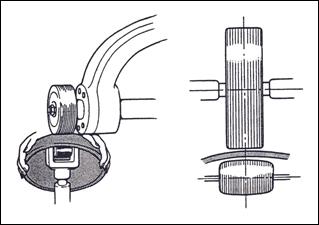
Figure 5: Wheeling Machine
2.4 Split-and-Weld System of Shaping Metal
The introduction of welding into the panel beater’s craft has led to the development of split-and-weld panel beating, which is at once less labourious and much quicker than the older methods of hollowing and raising. The system consists of making a pattern on a panel jig with pattern paper. The paper is held off the jig by tension at its edge. To allow the paper to drop on to the jig, the paper is slit at suitable points, the edges then opening out to let the pattern fall into position (figure 6). It is obvious, then that additional material is required at the slits. This may be obtained in the panel either by stretching the metal at these points until enough is obtained to meet the requirements, or by welding in V-shaped pieces of metal. The final shape is then achieved by wheeling or planishing.
Figure 6: Split-and-Weld Pattern
3.0 Damage Assessment
Before a systematic approach to body repairs is possible, it is necessary to understand the characteristics of sheet metal as used for body panels. When a flat sheet of metal is bent to a wide arc or radius it will regain its former shape when released, that is, it is elastic or possesses elasticity. However, if this sheet is bent to a short arc or radius it exceeds the limits of elasticity or flexibility, the metal in the bend becomes stiff and will take on a permanent set and retain the curvature. This is the result of the stresses which have been set up at the bend, making the material work hardened. Before the sheet is formed in the press the grain structure is constant and the thickness uniform throughout (figure 7).
When the metal is formed to make the body panel it is bent beyond its elastic limit. The outer surface stretches or lengthens while the inner surface shrinks or shortens (figure 8). The pressure exerted on the metal by the press also changes the grain structure to work harden the surface layers. This build-up of stresses in the bend or curve is an essential factor in the design of vehicle body panels which together form the body shell.
A common feature in the design and manufacture of a motor vehicle is the many curved surfaces which are normally referred to as crowns. Vehicle body panels consist of flat or slightly curved areas, sometimes quite large and elastic in nature (low crowns), such as door panels, these are held in position by stiffened, rigid sharp bends and swages which are non-elastic in nature (high crowns), such as wings (figure 9). If the panel is damaged in an accident the buckled area, being sharply bent, will create additional stiffness in the panel, whether in an elastic or non-elastic area. The slope of the buckles surrounding the sharp creases will be needed to reshape the sections of the panel which are made rigid either in manufacture or through accidental damage. When a panel becomes damaged due to impact, the resulting force on the metal causes buckling in the form of creases or ridges. Which are created because the panel has gone beyond its elastic limits to become non-elastic, therefore establishing unwanted rigid sections within the damaged area on the panel. The characteristic stiffness of the ridges prevents the panel returning to its original shape unless additional force is applied to release the stress in the ridges in the damaged area. When these stresses in the unwanted rigid areas are released, the elastic area will also be allowed to return to their original shape. It is important that these corrections be made in the right sequence on the individual panel; otherwise additional damage will be caused to the panels. Repairs must be performed using the reverse order and an opposing force to that of 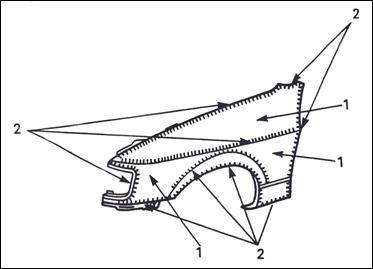 the original force which caused the damage.
the original force which caused the damage.
1. Low-crown, elastic areas
2. High-crown, rigid areas
Figure 9: Pressed wing panel
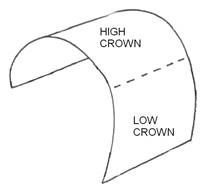 Consequently the correct sequence should be first to remove the last ridge which was formed and then to work towards the first point of impact of the damaged area.
Consequently the correct sequence should be first to remove the last ridge which was formed and then to work towards the first point of impact of the damaged area.
Figure 10: High/Low Crown
Rectification of vehicle bodies, following a true assessment of the damage, can be divided into two stages; roughing out or straightening of the reinforced sections and panels to approximately their original shape and the finishing or preparing of the surface to a smooth appearance for repainting. Both stages are of prime importance and many hours can be saved if the job is processed correctly. In cases of damage where the body is distorted, the temptation is to use rough-and-ready methods depending on brute force to restore some resemblance of shape. Whilst this may speed up the first stage of repair, it will be found that such methods result in additional markings on the panels, considerably more time will be spent on the final stage of finishing than would be required if more thought had been given to the job in the first instance and better methods had been used to rectify distortion. Damaged panels should be restored by relieving the stresses which have been set up by the force of impact. The skill of all body repair techniques lies in the correct handling of the basic hand tools, in variety of combinations best suited for the job in hand.
4.0 Preparing the Panel for Repair
4.1 Removal of Under-body Coatings
Before any repair procedure can be carried out on a given panel, the inner and outer surfaces must be thoroughly cleaned; deadeners, underseal and other foreign matter that might interfere with the application of corrective forces must be removed. Most of the anti-drumming and other under-coatings used today can be removed by scraper or putty knife after softening by the application of heat to the outside of the panel. Use a large tipped welding torch with a mild reducing flame. The outside of the panel should be washed down with clean water and any traces of oil, road tar or asphalt removed with a solvent soaked rag. This panel preparation will make hand tool straightening more effective, coupled with a reduction in wear and tear on the dollies etc. to be employed.
Sound Deadening, sealer trim glue removing tool
Plastic scrapers
4.2 Roughing Out Damage
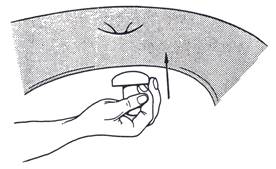 In minor repair work which can be carried out using hand tools, the first major operation is to reshape the damaged area back to its original contour. This is done by a technique known as roughing out, which must be carried out prior to any finishing process such as direct hammering or planishing. Roughing out is the reshaping of the area by hand with the aid of a heavy dolly, which forces back the damaged section to its original shape.
In minor repair work which can be carried out using hand tools, the first major operation is to reshape the damaged area back to its original contour. This is done by a technique known as roughing out, which must be carried out prior to any finishing process such as direct hammering or planishing. Roughing out is the reshaping of the area by hand with the aid of a heavy dolly, which forces back the damaged section to its original shape.
Figure 11 : Roughing out Damage
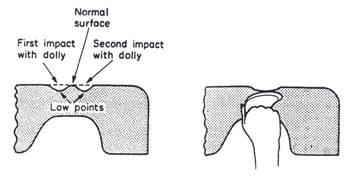 When repairing collision work, the normal method of correction is to reverse the process which caused the original damage. In the case of minor damage the point of impact is now the lowest part of the damage. To reverse the process this point on the underside of the panel should be struck using the same force as was originally directed against it. If this spot is hit accurately with a roughing out dolly using the same force, the panel will spring back almost to the contour it had prior to the damage. In some cases you will be able to correct the panel damage with a single blow which will spring the panel back to its original shape. In other cases, where the repair is larger, it will be found that several blows are necessary. Hold the roughing-out dolly lightly in the hand and strike the hardest blow at the centre of what appears to be the lowest point of the damage area, then direct the blows around the first one and gradually work outwards, decreasing the force of the blows until the damaged area has been roughed out (figure 11).
When repairing collision work, the normal method of correction is to reverse the process which caused the original damage. In the case of minor damage the point of impact is now the lowest part of the damage. To reverse the process this point on the underside of the panel should be struck using the same force as was originally directed against it. If this spot is hit accurately with a roughing out dolly using the same force, the panel will spring back almost to the contour it had prior to the damage. In some cases you will be able to correct the panel damage with a single blow which will spring the panel back to its original shape. In other cases, where the repair is larger, it will be found that several blows are necessary. Hold the roughing-out dolly lightly in the hand and strike the hardest blow at the centre of what appears to be the lowest point of the damage area, then direct the blows around the first one and gradually work outwards, decreasing the force of the blows until the damaged area has been roughed out (figure 11).
Figure 12 : Positioning of Blows in the Roughing-out Technique
However, in most cases the damage will not be completely restored to its original contour, although it will be roughed out and can be straightened to its original contour by direct hammering or by combination of direct hammering and indirect hammering.
The use of a heavy hammer for roughing out is not advisable, for this permits heavy blows which are concentrated in small areas and invariably results in stretching or otherwise distorting the metal, whereas a well directed blow with a dolly that matches the original contour of the repair spreads the blow over a larger area, resulting in very little distortion of the metal. In some cases body repair workers use a boxwood mallet for roughing out, because there is less chance of stretching the metal. The technique is similar to that of using a dolly, as the mallet is used on the inside of the panel to hammer the damaged section back to its original shape, then the work finished off by direct hammering using a panel hammer and dolly. A disadvantage in using a mallet is that on modern panel assemblies there is insufficient space to use a mallet for roughing out; therefore most body workers find a dolly more useful.
4.3 Planishing
The technique of planishing is a very old and established craft in the history of hand-fabricated metal articles. Basically planishing takes over from hollowing and raising, which shape the article to smooth its entire surface and finalise its shape. Planishing can be performed in three different ways; firstly, there is the technique which is used mostly by the panel beater in planishing new work. In this case a planishing hammer is used in conjunction with a steel stake, both having highly polished faces. The steel stake is mounted on the bench and is of a suitable curved shaped for the article being planished. The work is taken to the stake and planished over it to achieve the final finish. Second, there is the technique used by the body repair worker, where the planishing hammer is used in conjunction with a dolly block which is in fact a miniature stake or anvil, again with polished faces. The dolly block is held in place under the panel by hand, while the blows are directed on to the panel surface and transmitted through to the dolly block by the force of the blow being in direct contact with the hammer face, work surface and surfaces of the dolly block. In this method the tolls may be taken to the job and the work carried out on the spot. This fact makes planishing ideal for the repair of vehicle body panels. Third, there is the technique of planishing using the wheeling machine as a means of smoothing the work surface. This is accomplished by the friction and roll action of the workpiece as it passes between the steel rollers.
This method is normally used by panel beaters in smoothing and finalising new work, it can also be used by body repair workers, but the difficulty arises that the panel has to be dismantled and removed from the body shell, and is therefore an uneconomical proposition. Consequently planishing using a hand dolly and hammer is accepted universally as the best technique in the repair of panel surfaces by 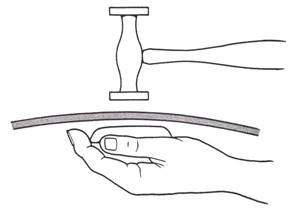 planishing.
planishing.
Figure 13 : Planishing using a Hammer and Dolly
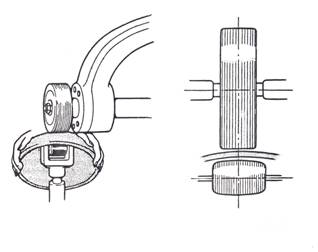 In some cases the three techniques can be used together; for instance a panel can be planished using a stake and then finished off by wheeling, or a panel can be wheeled, fitted to the job and then minor rectification carried out using a hand dolly and block. All three techniques have one common feature, when planishing the metal surface is slightly stretched because of the metal to metal contact between the working faces of the tools and the work face of the panel. The skill in this process lies in the fact that the craftsman has to merge, by careful hammer blows into one to create a continuous smooth surface.
In some cases the three techniques can be used together; for instance a panel can be planished using a stake and then finished off by wheeling, or a panel can be wheeled, fitted to the job and then minor rectification carried out using a hand dolly and block. All three techniques have one common feature, when planishing the metal surface is slightly stretched because of the metal to metal contact between the working faces of the tools and the work face of the panel. The skill in this process lies in the fact that the craftsman has to merge, by careful hammer blows into one to create a continuous smooth surface.
Figure 14 : Planishing using a Wheeling Machine
Where planishing hammers are employed, the process is carried out over a metal stake or hand dolly, the planishing is carried out over the whole surface of the workpiece; the blows are light and given squarely, otherwise they will produce crescent marks difficult to eliminate. Each hammer blow produces a flat spot and the blows are so directed that the spots merge imperceptibly into one another over the whole surface. Any low places or valleys on the surface of the workpiece can be eliminated by careful hammering on the head, which slightly stretches the metal, causing it to rise to the correct contours. Both the hammer face and the steel stake must be kept scrupulously clean and perfectly smooth, otherwise it will be impossible to avoid marking the sheet. Planishing should leave the metal with a dead smooth surface.
If this is not attained, small hammer marks can be removed by smoothing off with an emery cloth glued to a piece of wood and used like a file.
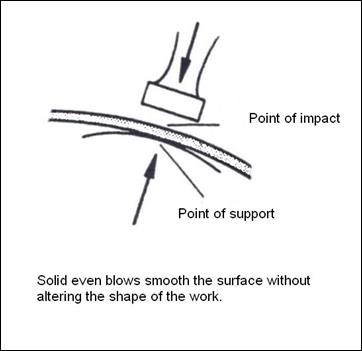
Figure 15: Planishing using a Steel Stake
5.0 Hammering Techniques
Unlike most other trades, where the hammer is used with a follow-though action from a combination of wrist, elbow and shoulder, in the skilled hands of a body repair worker the planishing hammer swing is a rhythmic action involving finger and wrist movement, producing a ringing blow (figure 16). The hammer should not be held tensely, but during the complete cycle of movement it should be held loosely in the hand. This will achieve a higher degree of accuracy and at the same time help to reduce fatigue. This loose holding of the hammer applies equally to dolly blocks, as it permits them to bounce back naturally and to assume the correct position for striking the next blow. With practice the wrist becomes strengthened and consequently working in restricted places becomes easier where an even wrist action is impossible. The dolly should be allowed to lie naturally in the hand with the face to be used uppermost and as with the hammer, should be held firmly but not tightly. Tap lightly at the dolly to obtain the feel of metal-on-metal and check for control of force of blow, each blow will give a metallic ring which should be the same for each stroke of the hammer. When no metallic ring is heard the hammer is not hitting the metal in alignment with the dolly.
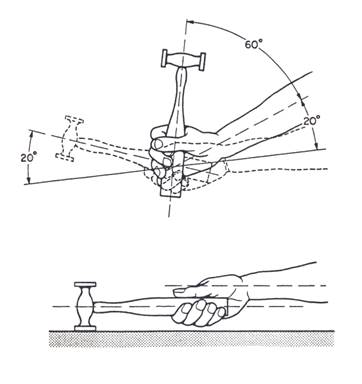
Figure 16: Swing of the Planishing Hammer
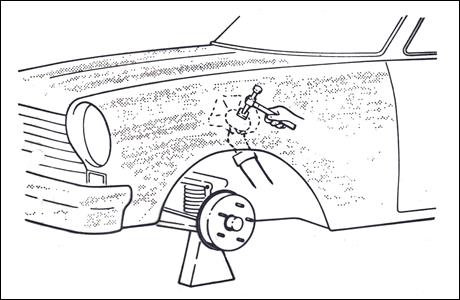
Figure 17 : Hammer and Dolly in Use
5.1 Direct Hammering
Direct hammering is in fact the process of planishing and the body repair worker uses it as a finishing process after the work has been pre-shaped and roughed out. It is the essential practice to master and develop as a result of continuous experience.
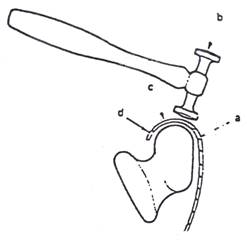 Before using the hammer and dolly together, it will be necessary to clean the underside of the portion of the wing or panel on which you will be working. Body panels and wings are covered with a sound deadening material which must be removed before starting the work. If you fail to clean the surface of this material it will not only stick to your dolly but will to a large degree destroy its effectiveness.
Before using the hammer and dolly together, it will be necessary to clean the underside of the portion of the wing or panel on which you will be working. Body panels and wings are covered with a sound deadening material which must be removed before starting the work. If you fail to clean the surface of this material it will not only stick to your dolly but will to a large degree destroy its effectiveness.
Figure 18 : Direct Hammering
It is most important to choose the correct dolly block for the job, because they differ in shape, curvature and weight. In repairing the high-crowned radius of a wing you will have to use a dolly block with a high-crowned radius. In repairing large body panels and door panels which are fairly flat it is necessary to use a dolly block with a low-crowned radius. In direct hammering, by having a dolly which matches the original contour under the damaged area and striking it with a hammer, you are pushing the uneven displaced metal surface back to its original contour to give a smooth and level finish.
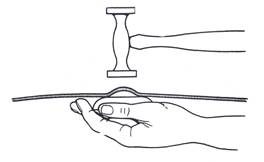 The dolly provides support and prevents the undamaged areas that have been previously roughed out from being pushed out of place. If you do not strike squarely over the dolly, you will be hitting an unsupported area of the repair and will displace the metal, creating further damage that must be rectified later. Direct hammering requires skill in directing the hammer blows and close observation of what you are doing so as not to hit the metal too hard, thereby displacing it.
The dolly provides support and prevents the undamaged areas that have been previously roughed out from being pushed out of place. If you do not strike squarely over the dolly, you will be hitting an unsupported area of the repair and will displace the metal, creating further damage that must be rectified later. Direct hammering requires skill in directing the hammer blows and close observation of what you are doing so as not to hit the metal too hard, thereby displacing it.
Figure 19 : The Technique of Direct Hammering
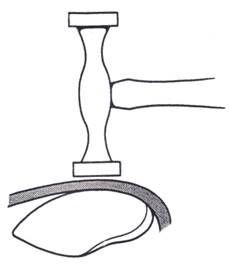 Perfect coordination between your two hands is necessary to enable you to move the dolly around under the damaged area and still continue to hit squarely over it with the hammer. Start hammering by using light blows, these will not do the job, but will show you whether or not you are hitting squarely over the dolly. Do not forget to let the dolly just lie in your hand and to grip the hammer loosely. A true ring will be heard if you are directly over the dolly otherwise the sound will be dull. Increase the force of the blow gradually until you have found just the right force to push the raised points of the roughed out section back without flattening the surrounding metal. The hammer should bounce back of its own accord so that it is ready for the next stroke.
Perfect coordination between your two hands is necessary to enable you to move the dolly around under the damaged area and still continue to hit squarely over it with the hammer. Start hammering by using light blows, these will not do the job, but will show you whether or not you are hitting squarely over the dolly. Do not forget to let the dolly just lie in your hand and to grip the hammer loosely. A true ring will be heard if you are directly over the dolly otherwise the sound will be dull. Increase the force of the blow gradually until you have found just the right force to push the raised points of the roughed out section back without flattening the surrounding metal. The hammer should bounce back of its own accord so that it is ready for the next stroke.
Figure 20 : Using a High-Crowned dolly
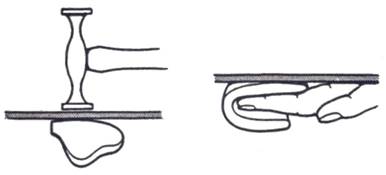
Figure 21 : Using a Low-Crowned Dolly
Likewise the dolly will spring away from the surface and the normal resilience of your arm will bring it back, striking a blow on the metal from underneath. These things will occur normally only if you hold both hammer and dolly loosely.
5.2 Indirect Hammering (off the dolly block)
Indirect hammering is another technique which uses hammer and dolly to level a panel surface. A low area can be raised by hammering round the outer edges in such a manner that the rebound action of the block tends to push the low area upwards to its original contour. This is achieved by the sequence of hammering just off, or at the side of, the dolly block, hence the name of indirect hammering. This technique is used in conjunction with direct hammering or planishing to achieve a final finish on the panel surface. Metal that has not been excessively hammered, displaced or stretched will have a tendency to return to its original contour of its own accord. This is due to the internal strain imparted to the metal by the forming dies in manufacture. If the metal is prevented from springing back by other strains imparted to it by additional bends or creases that have been formed by accident, the metal can be restored to its normal contour by relieving whatever new strain is holding it out of position.
In direct hammering a dolly block having correct contour to match the original shape of the panel is held under the low spot and a series of light blows are aimed around the outer edge of this low spot and slightly off the dolly block.
The light blows will not displace the surrounding area, but the force of the downward blow will be transferred to the dolly block. As a result of receiving the hammer blows indirectly, the dolly will rebound and the hand holding the block will automatically bring it back in place so that it imparts a light push upwards on the area. The centre of the damaged area will slowly rise until the original contour is restored.
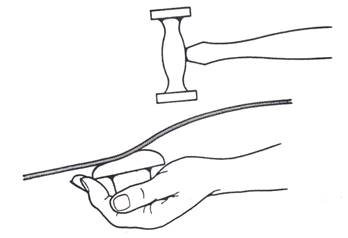
Figure 22 : The Technique of Spring Hammering
5.3 Spring Hammering
This is another technique of using hand tools to smooth and level a panel surface. In this case only a hammer which is not supported with a dolly block. The technique is used to reduce high spots which sometimes form as a panel is planished. In some cases these high spots can be reduced by careful, controlled hammering which spreads the force of the blow over the area of the metal, thus reducing the high spot. When a crown or curved surface is formed in a metal panel, it becomes strong in that it resists any change to its shape. The strength of this crowned surface can be used to support the surface being hammered without the use of a dolly. This type of hammering is called spring hammering and can be used to correct high spots on metal panel surfaces. To take advantage of a great amount of the natural support provided by the crown of the metal, the force of the hammer blow is spread over a larger area. Once the metal is back to its original contour, additional hammering will cause the surface to sink below its original contour line and it may be possible to raise it readily. Always start with light blows and as the repair nears completion, inspect the work after each blow.
This will reduce the possibility of sinking the surface too low. Keep the surface of the hammer face clean and highly polished. Any marks on the surface of the metal create additional work.
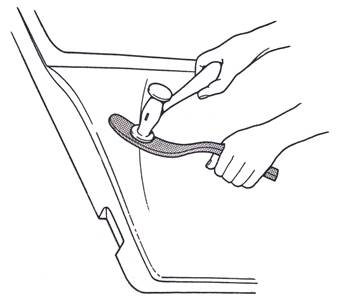
Figure 23 : The Technique of Spring Hammering
5.4 Removing Low Spots
Low spots can be removed in several ways, the two most common being the use of a pick hammer or a dolly block. When using the dolly block, start by holding it so that it can strike the underneath of the low spot on the panel with one of its rounded corners. It must be noted that if the operator does not hit exactly in the centre of the low spot, he will raise metal in some unwanted place. Accuracy is therefore essential and can be achieved by holding a finger in the low spot and lightly tapping the underside of the panel with the rounded corner of the dolly until you feel that it is exactly beneath your finger, then strike a sharp blow and raise the metal at this point. After each low spot has been raised in this manner, these points can be filed to check that they are level with the surrounding panel surface.
The second common method of raising low spots is by pick hammering. Bringing up low spots with a pick hammer is more difficult than by the use of a rounded corner of a dolly block. With a pick hammer more accurate placing of the blow is required. Likewise greater control over the force of the blow is necessary. Start using the pick hammer in a manner similar to the dolly block. Hold the end of your finger in the low spot, tap the under surface of the panel until the pick is directly below your finger. Then strike a light blow from beneath the panel, of sufficient strength to form a pimple in the low spot. Care must be taken to avoid overstretching the metal by using too hard a blow. These pimples represent stretched metal, but in being formed also raise the surrounding metal. When all the low spots have been raised with a pick hammer in this manner, the pimples can then be lightly hammered level by direct hammering and finished by filing.
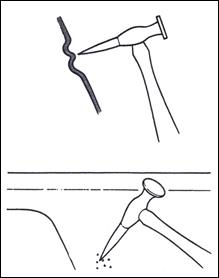
Figure 24 : Pick Hammering used to remove Low Spots
6.0 Filing Techniques
6.1 Filing
Filing is one of the most important aspects of finishing a body panel. It is carried out using an adjustable file holder, fitted with flexible blades which can be adjusted concave or convex to suit most contours on the average vehicle body. Initially the file was used for smoothing off panels prior to sanding and locating high and low spots. With the introduction of body solder and later metal and plastic fillers, filing took on an even greater importance in the finishing of repairs on body panels. Filing indicates any irregularities in the repaired surface of a panel and is carried out as the panel is planished. First of all fasten the correct blade to the file holder with the cutting edges of the teeth facing away from the handle or operator. Adjust the contour of the file holder so that it is almost, but not quite, matching the contour of the surface on which you intend to work.
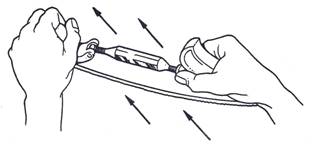 Figure 25 : Removes High and Low Spots on Metal Surface
Figure 25 : Removes High and Low Spots on Metal Surface
One hand is used to hold the file handle, while the other grasps the knob at the opposite end. The file should be applied with long, straight strokes, pushing it away from you along the length of the panel. Short, jabbing strokes should never be used, as these will only scratch the panel and will not indicate low spots. If the file digs in, too much pressure is being applied and hence a need for reduction is essential. At the end of the first stroke, raise the file and without dragging it over the metal, bring it back to the starting position and make a second stroke. Repeat this procedure until the area has been covered, making the file marks parallel to one another. This is termed line filing and indicates the levelness of the panel in the direction in which it has been filed. At this point both the high and low areas will shoe up. The high spots can be corrected by spring hammering and the low spots by direct hammering, pick hammering, or in some cases by using the corner of the dolly block. Line filing indicates curvature in one direction only and as most panels are double curved the panel surface must be cross filed to give an accurate contour check.
Cross filing means a change in the direction of the file strokes so that the file is moved at an angle between 45ºand 90º over the previous file strokes, thus checking the accuracy of the curvature in that direction. After filing, and prior to refinishing the panel, the damaged area is sanded using a fine-grit sanding disc which leaves a smooth, even surface ideally suited for painting.
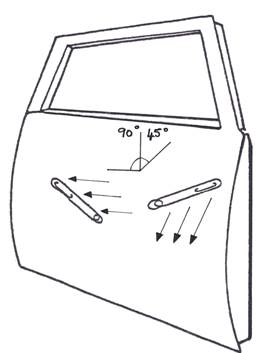
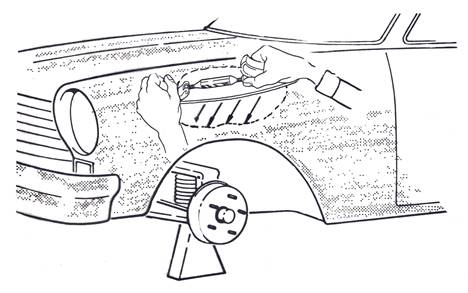 Figure 26 : Filing a Door Panel
Figure 26 : Filing a Door Panel
Figure 27 : Cross Filing at 45º
Figure 28 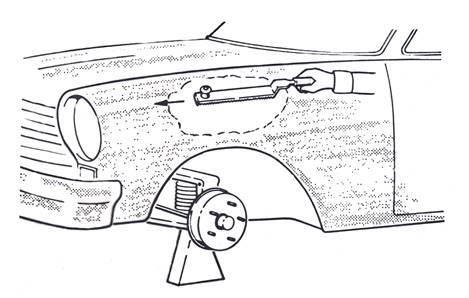 : Cross Filing at 90º
: Cross Filing at 90º
6.2 Grinding Techniques
Several general rules govern the use of the disc grinder. If these are observed they will enable the operator to become proficient very quickly in the use of the grinder. The rules are considered good shop practice and are directed towards the safety of the operator. In the first instance, if the device is electrically operated see that it is properly connected and earthed. Shop floors are usually of cement, they are generally moist and therefore, relatively good conductors of electricity. If the grinder is not properly earthed it is possible to receive a fatal electric shock when the machine is in use.
Summary
Metal finishing is a skilled job and perfection can only be achieved by plenty of practice. The correct selection and use of tools for the job in hand is vital to produce the perfect finish. Metal finishing is a hand craft that still retains its place in body work and as yet is irreplaceable by more modern methods, in spite of mechanical methods of repairing panels.
Source: http://local.ecollege.ie/Content/APPRENTICE/liu/vbr_notes/m2u2.doc
Web site to visit: http://local.ecollege.ie
Author of the text: indicated on the source document of the above text
If you are the author of the text above and you not agree to share your knowledge for teaching, research, scholarship (for fair use as indicated in the United States copyrigh low) please send us an e-mail and we will remove your text quickly. Fair use is a limitation and exception to the exclusive right granted by copyright law to the author of a creative work. In United States copyright law, fair use is a doctrine that permits limited use of copyrighted material without acquiring permission from the rights holders. Examples of fair use include commentary, search engines, criticism, news reporting, research, teaching, library archiving and scholarship. It provides for the legal, unlicensed citation or incorporation of copyrighted material in another author's work under a four-factor balancing test. (source: http://en.wikipedia.org/wiki/Fair_use)
The information of medicine and health contained in the site are of a general nature and purpose which is purely informative and for this reason may not replace in any case, the council of a doctor or a qualified entity legally to the profession.
The texts are the property of their respective authors and we thank them for giving us the opportunity to share for free to students, teachers and users of the Web their texts will used only for illustrative educational and scientific purposes only.
All the information in our site are given for nonprofit educational purposes